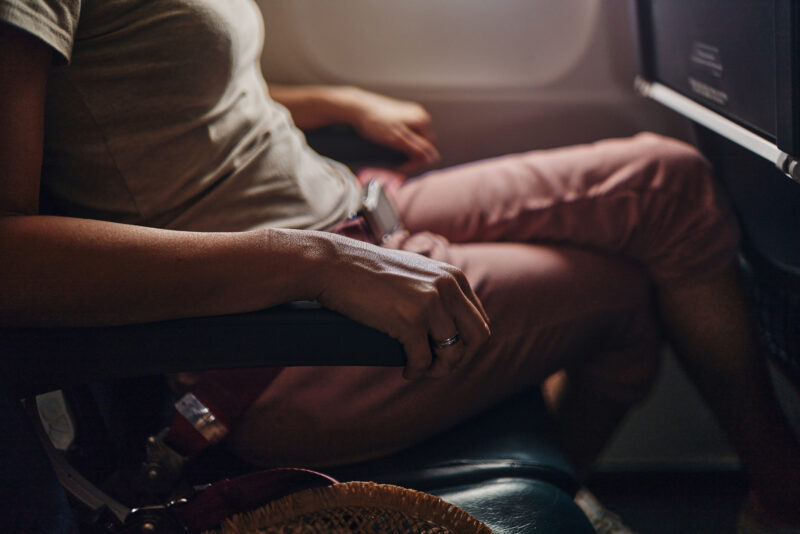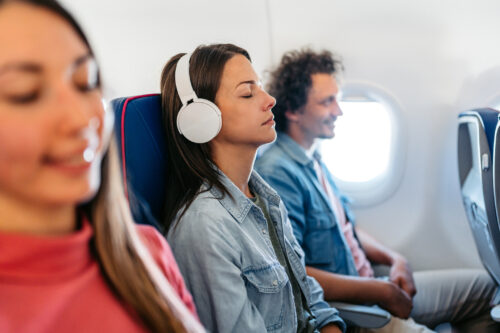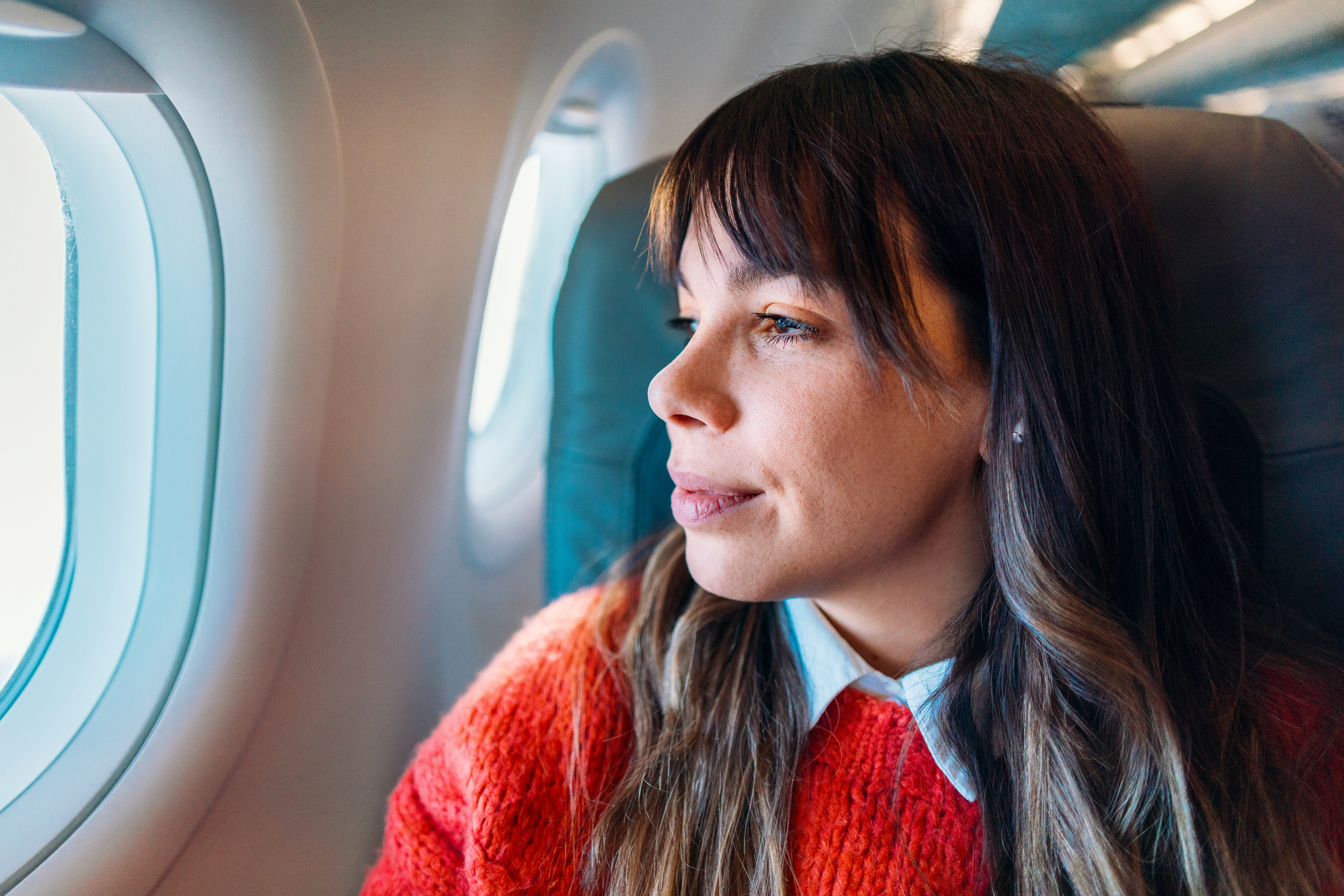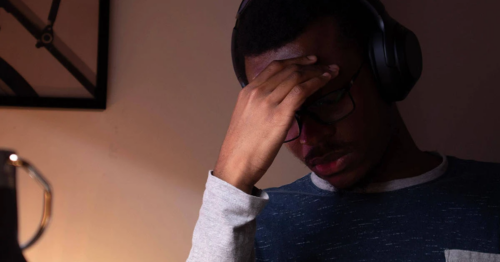
Table of Contents
Your Fear of Flying Might Be Aerophobia — Here’s What to Do About It
Written By: Charlie Health Editorial Team

Clinically Reviewed By: Courtney Way
April 11, 2025
6 min.
Fear of flying can make even the shortest trips feel overwhelming—but you’re not alone, and support is available. Read on to learn more.
Learn more about our Clinical Review Process
Table of Contents
For many people, the thought of stepping onto a plane brings excitement, adventure, or curiosity. For others, it sparks sweaty palms, racing thoughts, and an overwhelming desire to turn around and go home. If you fall into the latter group, you’re not alone. Fear of flying—also known as aerophobia or flying phobia—is one of the most common specific phobias worldwide. While modern air travel is widely regarded as the safest way to get from point A to point B, that doesn’t always translate into peace of mind.
Whether it’s turbulence or takeoff, you’re not alone—and there are real tools to help you feel more grounded in the sky.

Struggling with a fear of flying?
Learn how to manage aerophobia with expert-backed tools and compassionate support from Charlie Health.
Understanding the fear of flying
Fear is your brain’s built-in alarm system, designed to protect you from danger. When it detects a threat—real or perceived—it sets off a chain reaction to help you survive. At the center of that system is the amygdala, a small, almond-shaped structure that plays a key role in detecting fear and triggering the fight-or-flight response.
When you’re facing a situation that feels threatening—like getting on a plane, even if logically you know it’s safe—the amygdala sends signals to the rest of your body to prepare for danger. Your heart races, your muscles tense, and your breathing quickens. The problem is that when the brain interprets air travel as a threat, it activates this survival mode unnecessarily. This disconnect between perceived and actual danger is a core feature of flying-related anxiety and irrational fear.
Some people are also more vulnerable to developing phobias due to a combination of genetics, past trauma (like a turbulent flight or even a scary movie about a plane crash), and pre-existing mental health conditions such as panic disorder, social anxiety, or generalized anxiety disorder.
Triggers and mental health conditions associated with aerophobia
There’s no one-size-fits-all explanation for why someone becomes a nervous flyer, but several factors tend to play a role. Some of the most common triggers include:
- Turbulence (especially unexpected bumps during the flight)
- Feeling claustrophobic inside the aircraft
- Worrying about a plane accident or airplane crash
- Hearing distressing news stories about aviation incidents
- Not being in control, especially during takeoff and landing
- Being near someone else who appears anxious
- Past frightening flight experiences
For people already managing an anxiety disorder, flying can magnify existing symptoms. You might worry obsessively about what could go wrong, feel on edge for days leading up to your trip (anticipatory anxiety), or fear having a panic attack mid-flight. It can also manifest as physical symptoms, like increased heart rate or feeling like your heart is racing. Others may be dealing with OCD tendencies, like repeatedly checking their seatbelt or over-researching turbulence forecasts.
How fear of flying affects daily life
Fear of flying can reach far beyond the airplane cabin. It can impact your personal freedom, relationships, and career. You might avoid seeing loved ones who live far away, turn down work opportunities that require travel, or miss out on vacations. Planning a trip can trigger intense anxiety weeks in advance, leading to sleep issues, muscle tension, and constant worry. The day of the flight can bring on nausea, shaking, sweating, racing heart, and shortness of breath.
Even after the trip, many fearful fliers experience guilt or frustration, feeling like they “should” be able to handle it. But this self-judgment only feeds the cycle of anxious thoughts.
How to overcome your fear of flying
Before the flight
During the flight
After the flight
Preparing for a flight by learning about aviation safety, packing comforting items, and exploring professional support can help reduce anxiety before takeoff.
Creating a calming in-flight routine, practicing relaxation techniques, and seeking support from the flight crew can help manage anxiety in the moment.
Reflecting on your experience, celebrating progress, and tracking what worked can reinforce confidence and reduce fear over time.
Sometimes, just knowing what to expect can make a big difference. Whether it’s a short flight or international travel, these steps can help ease flying anxiety before, during, and after your journey.
Before the flight
- Do some research to understand how planes work and why flying is so safe
- Choose a seat that feels more comfortable—like over the wing or on the aisle
- Talk to a therapist or doctor about coping tools or short-term medication
- Pack comfort items like cozy clothes, a familiar scent, or a weighted blanket
During the flight
- Follow a calming routine with music, a movie, or journaling
- Practice breathing exercises or relaxation techniques to stay grounded
- Let the flight attendants know you’re feeling anxious—they’ll help
- Remind yourself that turbulence is normal and not a danger sign
After the flight
- Reflecting on what helped and what went better than expected
- Celebrating small wins and recognizing your progress
- Tracking each flight experience to build confidence over time
Support and tools to overcome the fear of flying
There’s strong research supporting a variety of methods for tackling flying fear that shows how brain regions like the amygdala react to flight-related stimuli—and how therapy can help calm that response over time. Studies consistently show that cognitive behavioral therapy (CBT) and exposure therapy can significantly reduce symptoms of phobia, especially when tailored to air travel. British Airways and other airlines have run specialized programs to help people work through their flying phobia, with many reporting long-term success.

If your flight anxiety is preventing you from living life fully—missing major events, skipping job opportunities, or enduring debilitating stress—it might be time to reach out for extra support.
1. Cognitive behavioral therapy (CBT)
CBT is one of the most effective treatments for flight anxiety and specific phobias. It helps you recognize unhelpful thought patterns—like catastrophizing about a plane crash—and replace them with more realistic and empowering perspectives. Over time, CBT retrains your brain to respond more calmly in anxiety-triggering situations.
2. Exposure therapy
Exposure therapy works by gradually introducing you to the thing you fear in a controlled, supportive environment. For fearful flyers, this might start with looking at pictures of airplanes, watching videos of takeoffs, or visiting an airport without boarding a flight. The idea is to build tolerance and reduce avoidance so flying feels less foreign and more familiar.
3. Grounding techniques
Grounding helps you stay connected to the present moment instead of spiraling into “what ifs.” One popular strategy is the 5-4-3-2-1 method: name 5 things you see, 4 you can touch, 3 you can hear, 2 you can smell, and 1 you can taste. You can also bring a small object—like a textured stone or soft cloth—to hold during the flight for a physical reminder of safety.
4. Apps and resources
There are several apps designed specifically to support anxious flyers. SOAR is a popular one created by a former pilot and licensed therapist, offering courses, turbulence forecasts, and calming tools. SkyGuru provides real-time explanations of flight events (like why the plane is banking), which can ease fears by making the unfamiliar more predictable.
5. Medication
Sometimes, medication can be a useful short-term tool. Fast-acting anti-anxiety medications like benzodiazepines (e.g., Xanax or Ativan) may be prescribed before flights, especially if the fear feels unmanageable. It’s important to talk to your healthcare provider about options and ensure the medication is used safely and sparingly.
6. Research
It can also be helpful to check the facts. Organizations like the International Air Transport Association and aviation safety databases also show that commercial air travel continues to be one of the safest transportation methods in the world.
7. Self-compassion
Above all, be kind to yourself. Flying anxiety is not a sign of weakness—it’s a real and valid experience. Remind yourself that progress is rarely linear, and facing your phobia is something that takes courage, not perfection.

How Charlie Health can help
If you or a loved one are struggling with aerophobia (the fear of flying), Charlie Health is here to help. Charlie Health’s virtual Intensive Outpatient Program (IOP) provides mental health treatment for people dealing with serious mental health conditions, including both the emotional and physical symptoms of phobias. Our expert clinicians incorporate evidence-based therapies into individual counseling, family therapy, and group sessions. With support, managing your mental health is possible. Fill out the form below or give us a call to start healing today.



